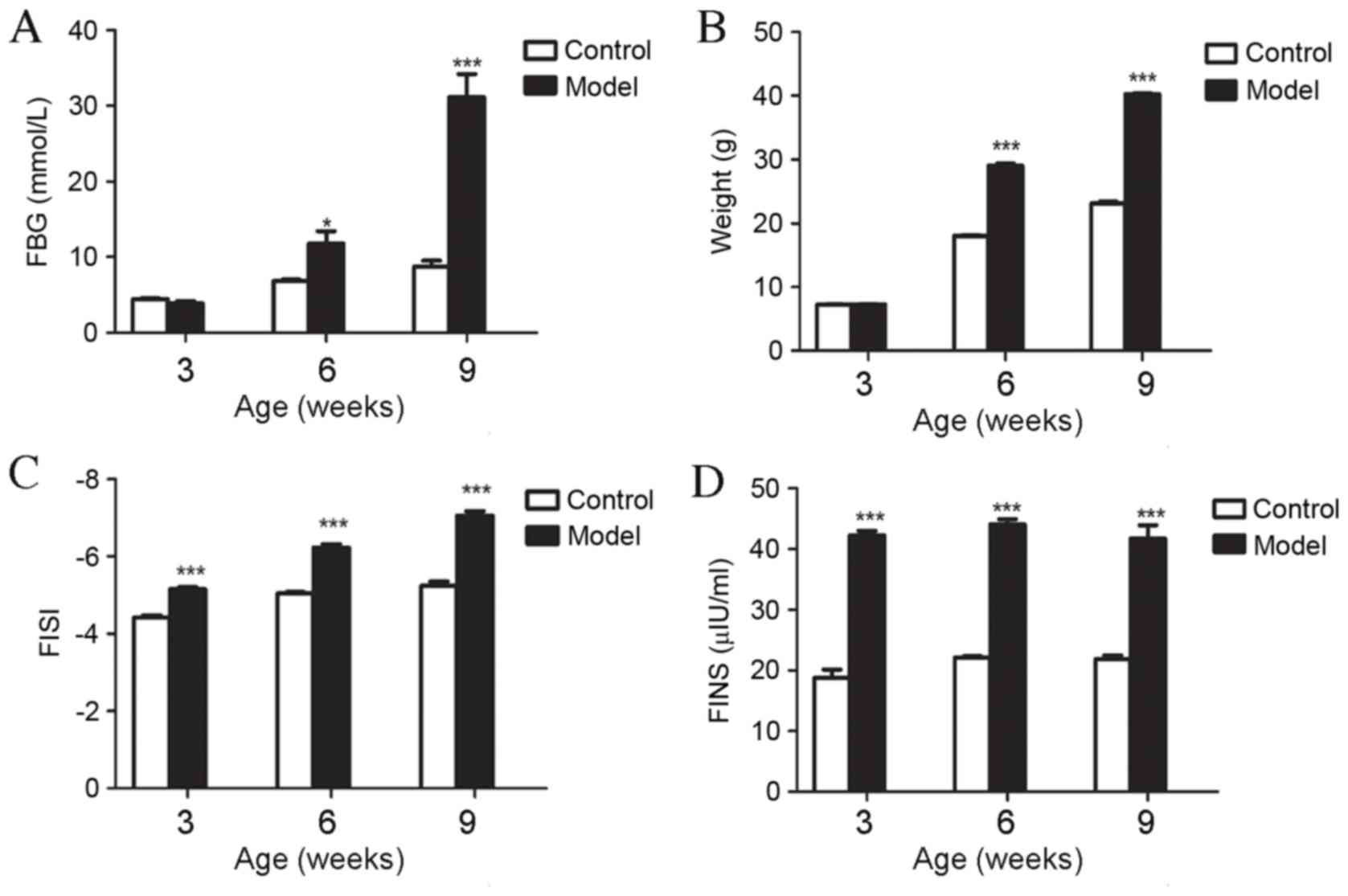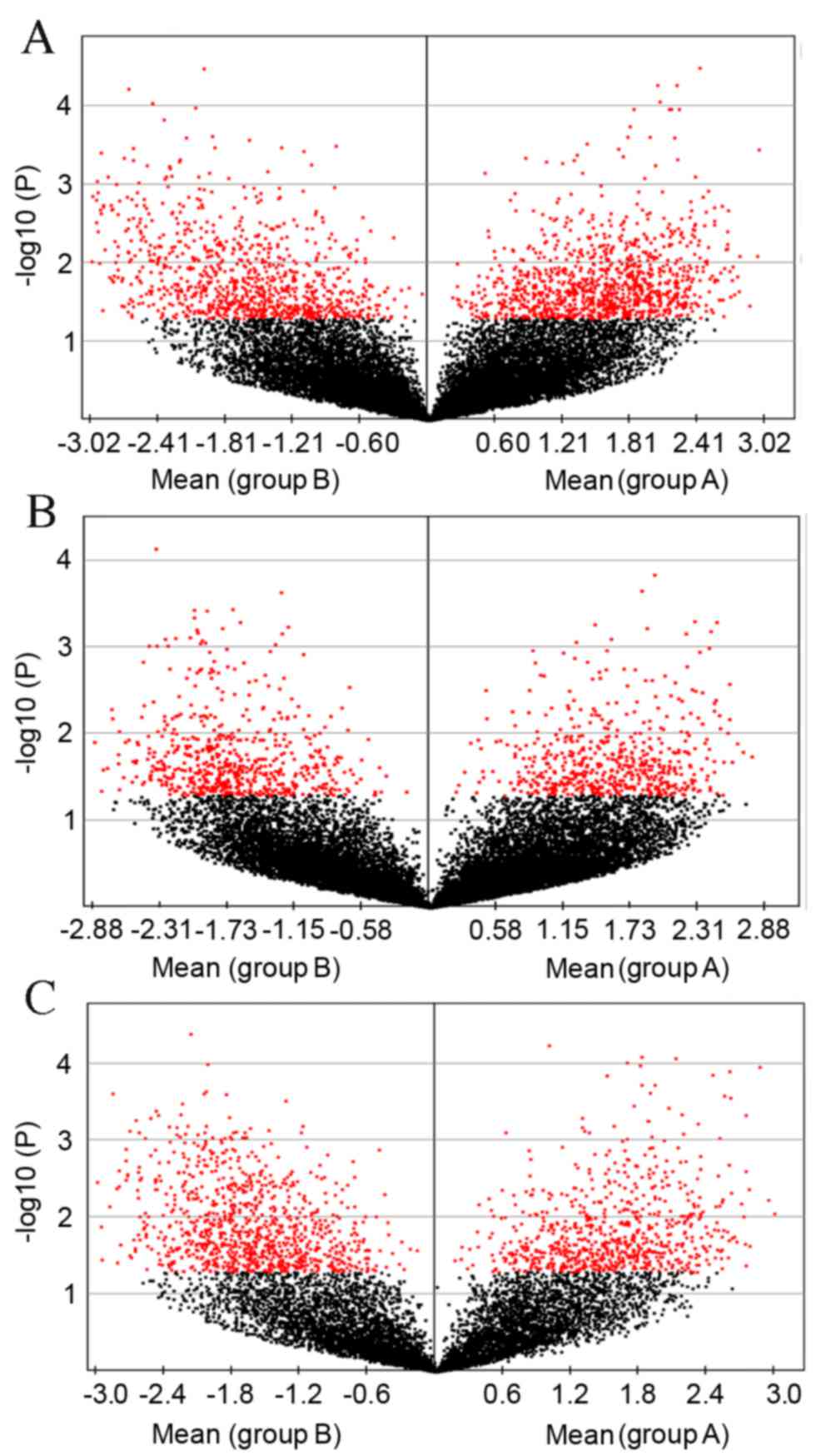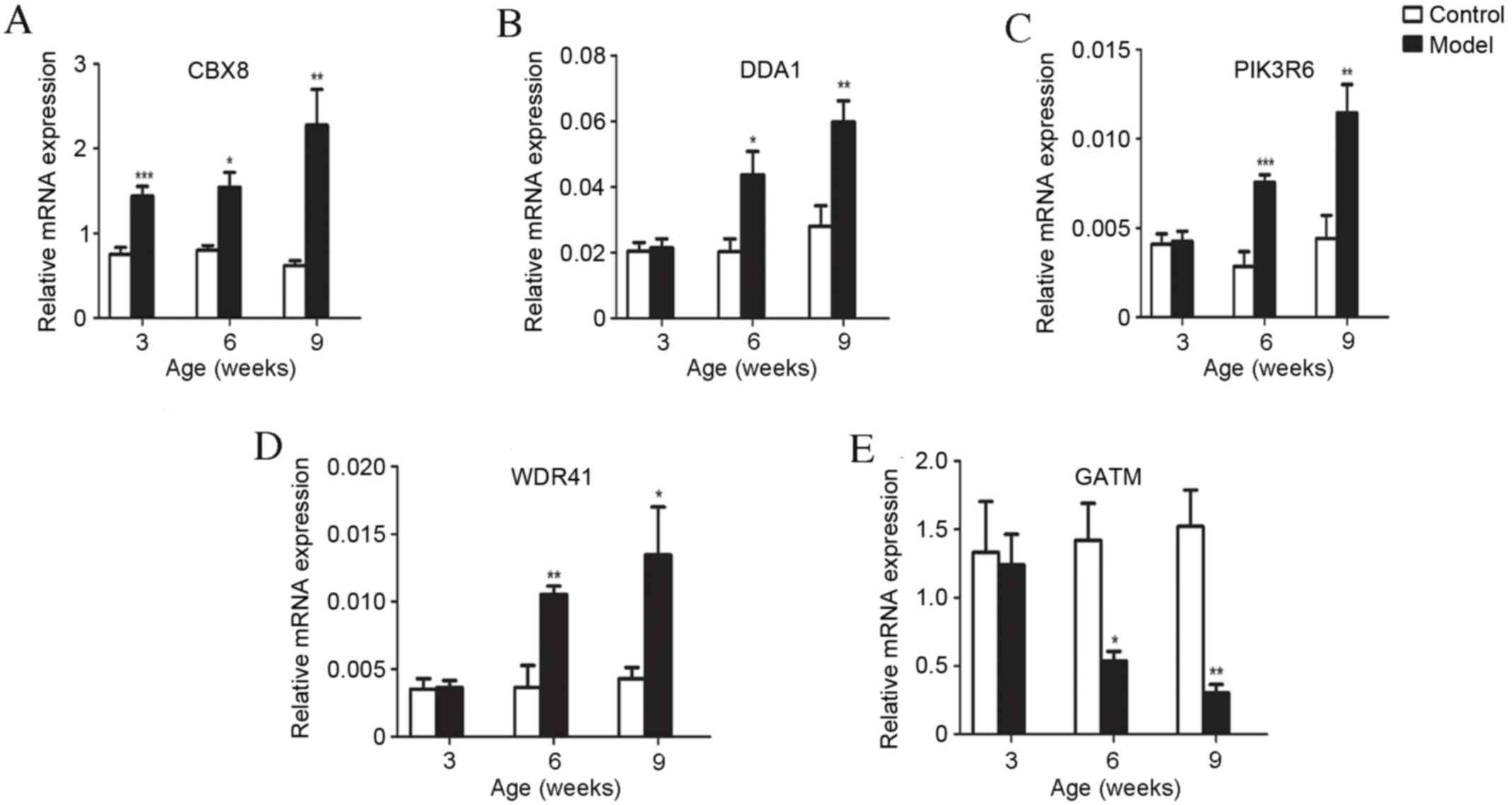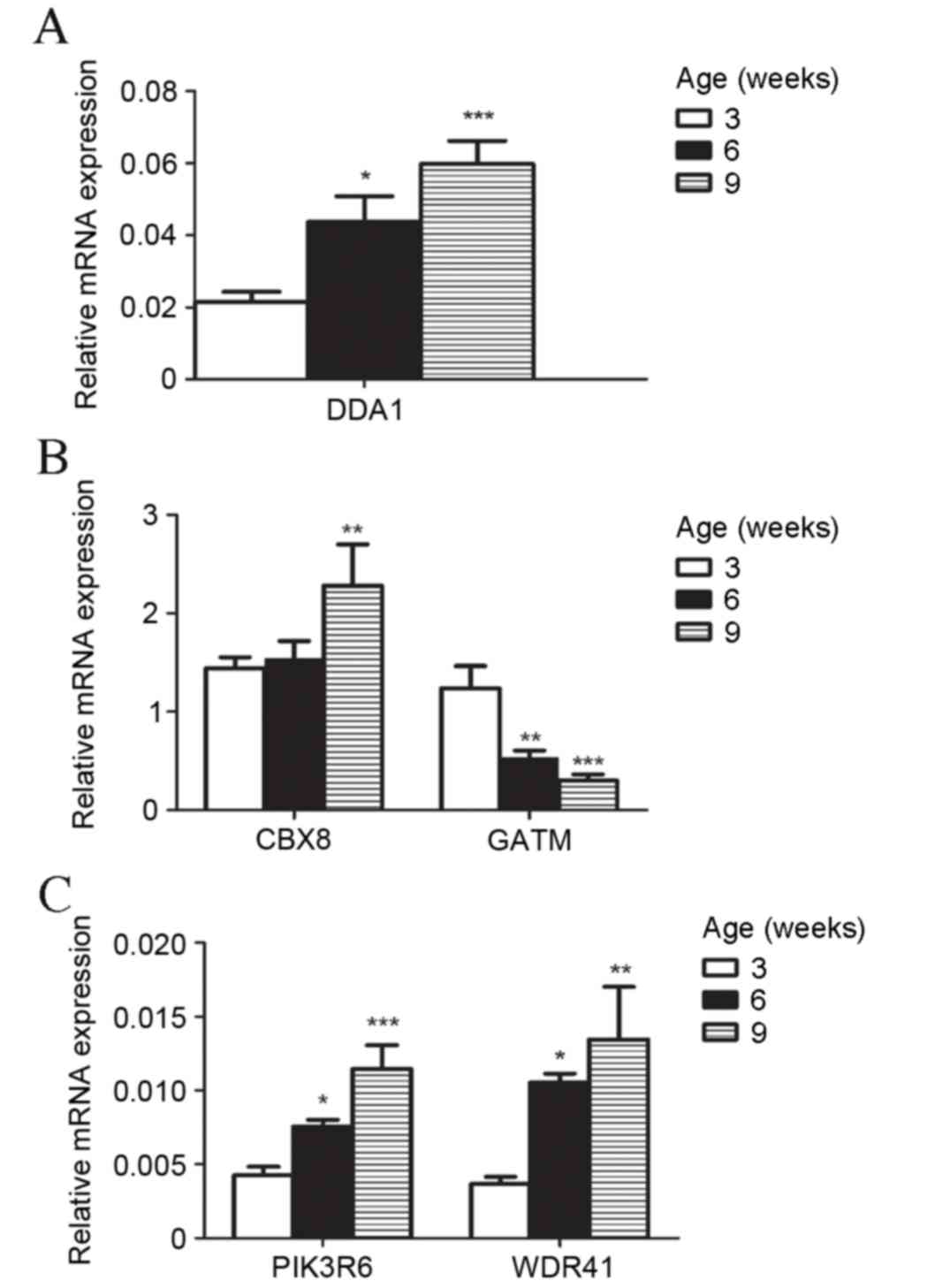|
1
|
Haslam DW and James WP: Obesity. Lancet.
366:1197–1209. 2005. View Article : Google Scholar : PubMed/NCBI
|
|
2
|
Langeveld M and Aerts JM:
Glycosphingolipids and insulin resistance. Prog Lipid Res.
48:196–205. 2009. View Article : Google Scholar : PubMed/NCBI
|
|
3
|
Ai J, Wang N, Yang M, Du ZM, Zhang YC and
Yang BF: Development of Wistar rat model of insulin resistance.
World J Gastroenterol. 11:3675–3679. 2005. View Article : Google Scholar : PubMed/NCBI
|
|
4
|
Stoffers DA: The development of beta-cell
mass: Recent progress and potential role of GLP-1. Horm Metab Res.
36:811–821. 2004. View Article : Google Scholar : PubMed/NCBI
|
|
5
|
Flück CE, Slotboom J, Nuoffer JM, Kreis R,
Boesch C and Mullis PE: Normal hepatic glycogen storage after
fasting and feeding in children and adolescents with type 1
diabetes. Pediatr Diabetes. 4:70–76. 2003. View Article : Google Scholar : PubMed/NCBI
|
|
6
|
Kuang H, Han D, Xie J, Yan Y, Li J and Ge
P: Profiling of differentially expressed microRNAs in premature
ovarian failure in an animal model. Gynecol Endocrinol. 30:57–61.
2014. View Article : Google Scholar : PubMed/NCBI
|
|
7
|
Hummel KP, Dickie MM and Coleman DL:
Diabetes, a new mutation in the mouse. Science. 153:1127–1128.
1966. View Article : Google Scholar : PubMed/NCBI
|
|
8
|
Yun KU, Ryu CS, Lee JY, Noh JR, Lee CH,
Lee HS, Kang JS, Park SK, Kim BH and Kim SK: Hepatic metabolism of
sulfur amino acids in db/db mice. Food Chem Toxicol. 53:180–186.
2013. View Article : Google Scholar : PubMed/NCBI
|
|
9
|
Davis RC, Castellani LW, Hosseini M,
Ben-Zeev O, Mao HZ, Weinstein MM, Jung DY, Jun JY, Kim JK, Lusis AJ
and Péterfy M: Early hepatic insulin resistance precedes the onset
of diabetes in obese C57BLKS-db/db mice. Diabetes. 59:1616–1625.
2010. View Article : Google Scholar : PubMed/NCBI
|
|
10
|
Permutt MA, Wasson J and Cox N: Genetic
epidemiology of diabetes. J Clin Invest. 115:1431–1439. 2005.
View Article : Google Scholar : PubMed/NCBI
|
|
11
|
Bonnefond A, Froguel P and Vaxillaire M:
The emerging genetics of type 2 diabetes. Trends Mol Med.
16:407–416. 2010. View Article : Google Scholar : PubMed/NCBI
|
|
12
|
Panzer C, Lauer MS, Brieke A, Blackstone E
and Hoogwerf B: Association of fasting plasma glucose with heart
rate recovery in healthy adults: A population-based study.
Diabetes. 51:803–807. 2002. View Article : Google Scholar : PubMed/NCBI
|
|
13
|
Lutz TA and Woods SC: Overview of animal
models of obesity. Curr Protoc Pharmacol Chapter 5: Unit5.61. 2012.
View Article : Google Scholar
|
|
14
|
Lee W, Ham J, Kwon HC, Kim YK and Kim SN:
Anti-diabetic effect of amorphastilbol through PPARα/γ dual
activation in db/db mice. Biochem Biophys Res Commun. 432:73–79.
2013. View Article : Google Scholar : PubMed/NCBI
|
|
15
|
Puff R, Dames P, Weise M, Göke B, Seissler
J, Parhofer KG and Lechner A: Reduced proliferation and a high
apoptotic frequency of pancreatic beta cells contribute to
genetically-determined diabetes susceptibility of db/db BKS mice.
Horm Metab Res. 43:306–311. 2011. View Article : Google Scholar : PubMed/NCBI
|
|
16
|
Dweep H, Sticht C, Kharkar A, Pandey P and
Gretz N: Parallel analysis of mRNA and microRNA microarray profiles
to explore functional regulatory patterns in polycystic kidney
disease: Using PKD/Mhm rat model. PLoS One. 8:e537802013.
View Article : Google Scholar : PubMed/NCBI
|
|
17
|
Maertens GN, El Messaoudi-Aubert S, Racek
T, Stock JK, Nicholls J, Rodriguez-Niedenführ M, Gil J and Peters
G: Several distinct polycomb complexes regulate and co-localize on
the INK4a tumor suppressor locus. PLoS One. 4:e63802009. View Article : Google Scholar : PubMed/NCBI
|
|
18
|
Bracken AP, Kleine-Kohlbrecher D, Dietrich
N, Pasini D, Gargiulo G, Beekman C, Theilgaard-Mönch K, Minucci S,
Porse BT, Marine JC, et al: The Polycomb group proteins bind
throughout the INK4A-ARF locus and are disassociated in senescent
cells. Genes Dev. 21:525–530. 2007. View Article : Google Scholar : PubMed/NCBI
|
|
19
|
Dietrich N, Bracken AP, Trinh E,
Schjerling CK, Koseki H, Rappsilber J, Helin K and Hansen KH:
Bypass of senescence by the polycomb group protein CBX8 through
direct binding to the INK4A-ARF locus. EMBO J. 26:1637–1648. 2007.
View Article : Google Scholar : PubMed/NCBI
|
|
20
|
Stott FJ, Bates S, James MC, McConnell BB,
Starborg M, Brookes S, Palmero I, Ryan K, Hara E, Vousden KH and
Peters G: The alternative product from the human CDKN2A locus,
p14(ARF), participates in a regulatory feedback loop with p53 and
MDM2. EMBO J. 17:5001–5014. 1998. View Article : Google Scholar : PubMed/NCBI
|
|
21
|
Kamijo T, Weber JD, Zambetti G, Zindy F,
Roussel MF and Sherr CJ: Functional and physical interactions of
the ARF tumor suppressor with p53 and Mdm2. Proc Natl Acad Sci USA.
95:8292–8297. 1998. View Article : Google Scholar : PubMed/NCBI
|
|
22
|
Zhang Y, Xiong Y and Yarbrough WG: ARF
promotes MDM2 degradation and stabilizes p53: ARF-INK4a locus
deletion impairs both the Rb and p53 tumor suppression pathways.
Cell. 92:725–734. 1998. View Article : Google Scholar : PubMed/NCBI
|
|
23
|
Pomerantz J, Schreiber-Agus N, Liégeois
NJ, Silverman A, Alland L, Chin L, Potes J, Chen K, Orlow I, Lee
HW, et al: The Ink4a tumor suppressor gene product, p19Arf,
interacts with MDM2 and neutralizes MDM2's inhibition of p53. Cell.
92:713–723. 1998. View Article : Google Scholar : PubMed/NCBI
|
|
24
|
Yang S, Wang B, Humphries F, Hogan AE,
O'Shea D and Moynagh PN: The E3 ubiquitin ligase Pellino3 protects
against obesity-induced inflammation and insulin resistance.
Immunity. 41:973–987. 2014. View Article : Google Scholar : PubMed/NCBI
|
|
25
|
Pick E, Lau OS, Tsuge T, Menon S, Tong Y,
Dohmae N, Plafker SM, Deng XW and Wei N: Mammalian DET1 regulates
Cul4A activity and forms stable complexes with E2
ubiquitin-conjugating enzymes. Mol Cell Biol. 27:4708–4719. 2007.
View Article : Google Scholar : PubMed/NCBI
|
|
26
|
Bates S, Phillips AC, Clark PA, Stott F,
Peters G, Ludwig RL and Vousden KH: p14ARF links the tumour
suppressors RB and p53. Nature. 395:124–125. 1998. View Article : Google Scholar : PubMed/NCBI
|
|
27
|
de Stanchina E, McCurrach ME, Zindy F,
Shieh SY, Ferbeyre G, Samuelson AV, Prives C, Roussel MF, Sherr CJ
and Lowe SW: E1A signaling to p53 involves the p19(ARF) tumor
suppressor. Genes Dev. 12:2434–2442. 1998. View Article : Google Scholar : PubMed/NCBI
|
|
28
|
Zindy F, Eischen CM, Randle DH, Kamijo T,
Cleveland JL, Sherr CJ and Roussel MF: Myc signaling via the ARF
tumor suppressor regulates p53-dependent apoptosis and
immortalization. Genes Dev. 12:2424–2433. 1998. View Article : Google Scholar : PubMed/NCBI
|
|
29
|
Radfar A, Unnikrishnan I, Lee HW, DePinho
RA and Rosenberg N: p19(Arf) induces p53-dependent apoptosis during
abelson virus-mediated pre-B cell transformation. Proc Natl Acad
Sci USA. 95:13194–13199. 1998. View Article : Google Scholar : PubMed/NCBI
|
|
30
|
Nacerddine K, Beaudry JB, Ginjala V,
Westerman B, Mattiroli F, Song JY, van der Poel H, Ponz OB,
Pritchard C, Cornelissen-Steijger P, et al: Akt-mediated
phosphorylation of Bmi1 modulates its oncogenic potential, E3
ligase activity and DNA damage repair activity in mouse prostate
cancer. J Clin Invest. 122:1920–1932. 2012. View Article : Google Scholar : PubMed/NCBI
|
|
31
|
Kitagishi Y, Nakanishi A, Minami A, Asai
Y, Yasui M, Iwaizako A, Suzuki M, Ono Y, Ogura Y and Matsuda S:
Certain diet and lifestyle may contribute to islet β-cells
protection in type-2 diabetes via the modulation of cellular
PI3K/AKT Pathway. Open Biochem J. 8:74–82. 2014. View Article : Google Scholar : PubMed/NCBI
|
|
32
|
Biethahn K, Orinska Z, Vigorito E,
Goyeneche-Patino DA, Mirghomizadeh F, Föger N and Bulfone-Paus S:
miRNA-155 controls mast cell activation by regulating the PI3Kγ
pathway and anaphylaxis in a mouse model. Allergy. 69:752–762.
2014. View Article : Google Scholar : PubMed/NCBI
|
|
33
|
Engelman JA, Luo J and Cantley LC: The
evolution of phosphatidylinositol 3-kinases as regulators of growth
and metabolism. Nat Rev Genet. 7:606–619. 2006. View Article : Google Scholar : PubMed/NCBI
|
|
34
|
Martin D, Galisteo R, Molinolo AA, Wetzker
R, Hirsch E and Gutkind JS: PI3Kγ mediates kaposi's
sarcoma-associated herpesvirus vGPCR-induced sarcomagenesis. Cancer
Cell. 19:805–813. 2011. View Article : Google Scholar : PubMed/NCBI
|
|
35
|
Prasad SV Naga, Laporte SA, Chamberlain D,
Caron MG, Barak L and Rockman HA: Phosphoinositide 3-kinase
regulates beta2-adrenergic receptor endocytosis by AP-2 recruitment
to the receptor/beta-arrestin complex. J Cell Biol. 158:563–575.
2002. View Article : Google Scholar : PubMed/NCBI
|
|
36
|
Vadas O, Dbouk HA, Shymanets A, Perisic O,
Burke JE, Abi Saab WF, Khalil BD, Harteneck C, Bresnick AR,
Nürnberg B, et al: Molecular determinants of PI3Kγ-mediated
activation downstream of G-protein-coupled receptors (GPCRs). Proc
Natl Acad Sci USA. 110:18862–18867. 2013. View Article : Google Scholar : PubMed/NCBI
|
|
37
|
Geering B, Cutillas PR, Nock G, Gharbi SI
and Vanhaesebroeck B: Class IA phosphoinositide 3-kinases are
obligate p85-p110 heterodimers. Proc Natl Acad Sci USA.
104:7809–7814. 2007. View Article : Google Scholar : PubMed/NCBI
|
|
38
|
Zhu S, Sun F, Li W, Cao Y, Wang C, Wang Y,
Liang D, Zhang R, Zhang S, Wang H and Cao F: Apelin stimulates
glucose uptake through the PI3K/Akt pathway and improves insulin
resistance in 3T3-L1 adipocytes. Mol Cell Biochem. 353:305–313.
2011. View Article : Google Scholar : PubMed/NCBI
|
|
39
|
Walker JB: Creatine: Biosynthesis,
regulation, and function. Adv Enzymol Relat Areas Mol Biol.
50:177–242. 1979.PubMed/NCBI
|
|
40
|
Hansen JS, Zhao X, Irmler M, Liu X, Hoene
M, Scheler M, Li Y, Beckers J, Hrabĕ de Angelis M, Häring HU, et
al: Type 2 diabetes alters metabolic and transcriptional signatures
of glucose and amino acid metabolism during exercise and recovery.
Diabetologia. 58:1845–1854. 2015. View Article : Google Scholar : PubMed/NCBI
|
|
41
|
Choe CU, Nabuurs C, Stockebrand MC, Neu A,
Nunes P, Morellini F, Sauter K, Schillemeit S, Hermans-Borgmeyer I,
Marescau B, et al: L-arginine: Glycine amidinotransferase
deficiency protects from metabolic syndrome. Hum Mol Genet.
22:110–123. 2013. View Article : Google Scholar : PubMed/NCBI
|
|
42
|
Sharma BR, Kim HJ and Rhyu DY: Caulerpa
lentillifera extract ameliorates insulin resistance and regulates
glucose metabolism in C57BL/KsJ-db/db mice via PI3K/AKT signaling
pathway in myocytes. J Transl Med. 13:622015. View Article : Google Scholar : PubMed/NCBI
|
|
43
|
Mithieux G, Gautier-Stein A, Rajas F and
Zitoun C: Contribution of intestine and kidney to glucose fluxes in
different nutritional states in rat. Comp Biochem Physiol B Biochem
Mol Biol. 143:195–200. 2006. View Article : Google Scholar : PubMed/NCBI
|
|
44
|
Smith TF: Diversity of WD-repeat proteins.
Subcell Biochem. 48:20–30. 2008. View Article : Google Scholar : PubMed/NCBI
|
|
45
|
Xu C and Min J: Structure and function of
WD40 domain proteins. Protein Cell. 2:202–214. 2011. View Article : Google Scholar : PubMed/NCBI
|
|
46
|
Stirnimann CU, Petsalaki E, Russell RB and
Müller CW: WD40 proteins propel cellular networks. Trends Biochem
Sci. 35:565–574. 2010. View Article : Google Scholar : PubMed/NCBI
|
|
47
|
Teperino R, Schoonjans K and Auwerx J:
Histone methyl transferases and demethylases; can they link
metabolism and transcription? Cell Metab. 12:321–327. 2010.
View Article : Google Scholar : PubMed/NCBI
|
|
48
|
Jufvas A, Sjödin S, Lundqvist K, Amin R,
Vener AV and Strålfors P: Global differences in specific histone H3
methylation are associated with overweight and type 2 diabetes.
Clin Epigenetics. 5:152013. View Article : Google Scholar : PubMed/NCBI
|













